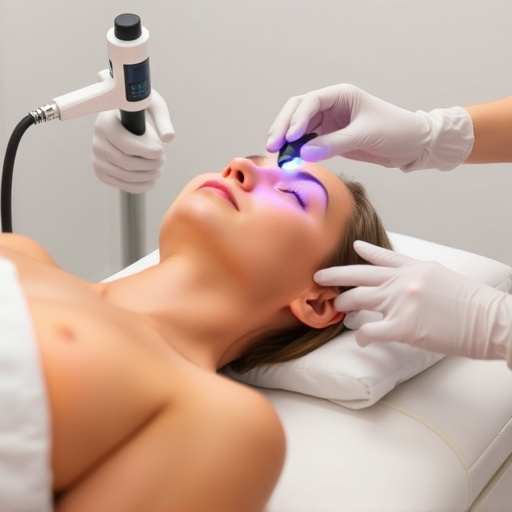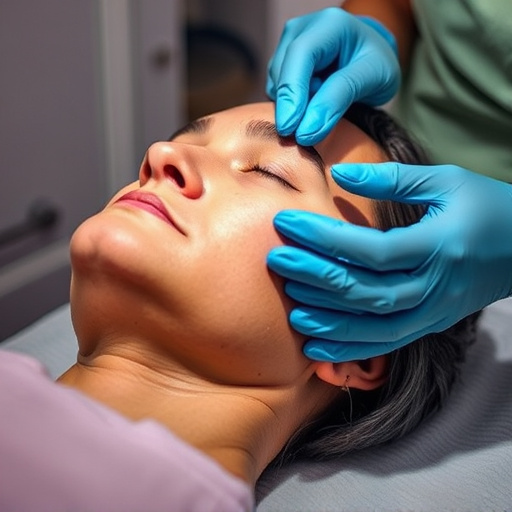Skin tightening procedures using laser and radiofrequency technology have gained popularity as non-surgical alternatives for body contouring. These treatments stimulate fibroblasts to boost collagen production, improving skin elasticity and reducing wrinkles. Radiofrequency further enhances results by heating deeper layers for muscle contractions. As sought-after options for achieving a rejuvenated look, these innovative procedures offer minimal downtime and tailored skincare solutions. However, risks like redness and temporary sensitivity necessitate consulting a qualified dermatologist to understand expectations and potential contraindications.
“Uncover the secrets to achieving a youthful glow with our comprehensive guide to skin tightening using cutting-edge technology. This article delves into the world of laser and radiofrequency skin tightening, offering insights for those seeking to reduce wrinkles and improve skin elasticity.
We explore the science behind these non-invasive procedures, unraveling how lasers and radiofrequencies stimulate collagen production. Additionally, we weigh the benefits, risks, and considerations, ensuring you’re informed before embarking on your journey towards smoother, tighter skin.”
- Understanding Skin Tightening with Laser and Radiofrequency
- The Science Behind These Procedures: How They Work
- Benefits, Risks, and Considerations for Skin Tightening Treatments
Understanding Skin Tightening with Laser and Radiofrequency

Skin tightening with laser and radiofrequency technology has emerged as a popular non-surgical treatment option for those seeking to enhance their skin health and appearance. These innovative procedures offer a minimal-to-no downtime alternative to traditional surgical lifts, targeting both collagen production and muscle tone.
By emitting targeted energy into the skin, lasers and radiofrequency devices stimulate fibroblasts, the cells responsible for generating collagen. This process not only improves skin elasticity, reducing the depth of wrinkles, but also leads to a more youthful and firm complexion. Radiofrequency treatments further benefit the skin by heating the deeper layers, causing contractions in the muscles beneath, which contributes to a noticeable tightening effect. As such, these non-surgical treatments have become go-to options for achieving a rejuvenated look and maintaining optimal skin health.
The Science Behind These Procedures: How They Work

The science behind skin tightening procedures like laser and radiofrequency treatments revolves around stimulating collagen production. Both methods use focused energy to penetrate the skin’s deeper layers, causing micro-injuries that trigger a natural healing response. This process encourages the body to create new collagen and elastin fibers, which are essential for maintaining skin elasticity and firmness. Collagen is a key protein that provides structure and support to our skin, making it an integral part of any effective skin tightening strategy.
Personalized skincare plays a crucial role in enhancing these treatments’ outcomes. By understanding individual skin concerns, such as pore refinement or specific area treatments, specialized professionals can tailor customized facials and procedures. These personalized approaches ensure that the skin tightening procedure targets problem areas directly, maximizing results while minimizing potential side effects.
Benefits, Risks, and Considerations for Skin Tightening Treatments

Skin tightening treatments using laser or radiofrequency offer a non-invasive way to improve skin elasticity and reduce the appearance of wrinkles and saggy skin. One of the key benefits is their ability to stimulate collagen production, leading to firmer, smoother skin. These procedures are particularly appealing for those seeking body contouring without surgery, targeting problem areas like the abdomen, arms, or thighs.
However, there are risks and considerations associated with these treatments. Potential side effects may include redness, swelling, and temporary sensitivity, especially with laser-based methods. In rare cases, skin discoloration or burns can occur if not performed correctly. It’s crucial to choose a qualified professional for the procedure, as improper use of technology like microneedling therapy or even laser hair removal can lead to complications. Before undergoing any skin tightening treatment, consulting with a dermatologist is essential to understand expectations, potential outcomes, and any contraindications based on individual skin conditions.
Skin tightening procedures using laser or radiofrequency technologies offer promising solutions for achieving a more youthful appearance. By targeting collagen production and muscle tone, these non-invasive treatments can provide significant improvements in skin elasticity and texture. However, as with any cosmetic procedure, it’s essential to weigh the benefits against potential risks and consider individual factors before making a decision. Consulting with a qualified professional is crucial to determining if a laser or radiofrequency skin tightening treatment is the right choice for achieving your desired aesthetic goals.














